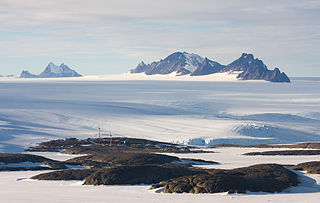A request that this article title be changed to Auster is under discussion . Please do not move this article until the discussion is closed. |
Auster was a British aircraft manufacturer.
Auster may also refer to:
A request that this article title be changed to Auster is under discussion . Please do not move this article until the discussion is closed. |
Auster was a British aircraft manufacturer.
Auster may also refer to:

Auster Aircraft Limited was a British aircraft manufacturer from 1938 to 1961.

Mawson Station, commonly called Mawson, is one of three permanent bases and research outposts in Antarctica managed by the Australian Antarctic Division (AAD). Mawson lies in Holme Bay in Mac. Robertson Land, East Antarctica in the Australian Antarctic Territory, a territory claimed by Australia. Established in 1954, Mawson is Australia's oldest Antarctic station and the oldest continuously inhabited Antarctic station south of the Antarctic Circle. It houses approximately 20 personnel over winter and up to 53 in summer.
Lang may refer to:

The McMurdo Sound is a sound in Antarctica, known as the southernmost passable body of water in the world, located approximately 1,300 kilometres (810 mi) from the South Pole.
Beaver Glacier is a glacier about 15 miles (24 km) long and 4 miles (6 km) wide, flowing west into Amundsen Bay between Auster Glacier and Mount Gleadell. The head of Beaver Glacier is located very close to the base of Mount King in Enderby Land. It was visited by an Australian National Antarctic Research Expeditions (ANARE) party on October 28, 1956, and named after the Beaver aircraft used by ANARE in coastal exploration.

Port Stanley Airport is an airport in the Falkland Islands, two miles outside the capital, Stanley. The airport is the only civilian airport in the islands with a paved runway. However, RAF Mount Pleasant, located to the west of Stanley, functions as the islands' main international airport, because it has a long runway and allows civilian flights. Port Stanley Airport is operated by the Government of the Falkland Islands, and is used for internal flights between the islands and flights between the Falklands and Antarctica.
The Norwegian–British–Swedish Antarctic Expedition (1949–1952) was the first Antarctica expedition involving an international team of scientists. The team members came from Norway, Sweden and the British Commonwealth of Nations.

The Taylorcraft Auster was a British military liaison and observation aircraft produced by the Taylorcraft Aeroplanes (England) Limited company during the Second World War.

The Auster J/1 Autocrat was a 1940s British single-engined three-seat high-wing touring monoplane built by Auster Aircraft Limited at Rearsby, Leicestershire.

The Auster J/4 was a 1940s British single-engined two-seat high-wing touring monoplane built by Auster Aircraft Limited at Rearsby, Leicestershire.

The Beagle Husky was a three-seat British light aircraft built in the 1960s which originated from a Portuguese Air Force requirement for a liaison/training aircraft, a development of the Auster Alpha. It first flew as an Auster design in January 1960, but that company was taken over by Beagle Aircraft in September that year. It was initially available with a 160 hp Lycoming O-320 engine as the Auster D5/160.
A rookery is a colony of breeding birds and some marine mammals.

Auster Rookery is an Emperor penguin rookery on sea-ice, sheltered by grounded icebergs, 5 kilometres (2.7 nmi) east of the Auster Islands, and about 51 kilometres (28 nmi) ENE of Mawson Station in Antarctica. It was discovered in August 1957 by Flying Officer D. Johnston, RAAF, from an ANARE Auster aircraft, after which it was named. The rookery was estimated in 2009 to contain 7,855 individual emperor penguins, and has been designated an Important Bird Area by BirdLife International.
The Antarctic Flight was a Royal Australian Air Force (RAAF) aircraft flight. It operated from RAAF Base Laverton and Mawson Station. The flight was responsible for expeditions and rescue missions in Antarctica.

Charcot Bay is a bay about 10 nautical miles (20 km) wide between Cape Kater and Cape Kjellman along the Davis Coast of Graham Land. It was discovered by the Swedish Antarctic Expedition, 1901–04, under Otto Nordenskiöld. He named it for Dr. Jean-Baptiste Charcot, a noted Arctic explorer.
Haswell Island is the largest of the Haswell Islands, lying off the coast of Antarctica, about 3 kilometres (1.5 nmi) north of Mabus Point in Queen Mary Land. It was discovered by the Western Base Party of the Australasian Antarctic Expedition, 1911–14, under Mawson, and named by him for Professor William A. Haswell, a zoologist at Sydney University and a member of the expedition's Advisory Committee.
Landmark Point is a rocky point lying 1 kilometre (0.5 nmi) southeast of Safety Island, on the coast of Mac. Robertson Land, Antarctica. It was mapped from Australian National Antarctic Research Expeditions surveys and air photos, 1956–66, and was so named by the Antarctic Names Committee of Australia because it is almost due south from Auster Rookery and affords an excellent landmark if approaching the rookery along the coast from Mawson Station.

Penshurst Airfield was an airfield in operation between 1916–36 and 1940–46. Initially a military airfield, after the First World War it was used as an alternate destination to Croydon Airport, with some civil flying taking place. The airfield closed following the crash of a Flying Flea at an air display in 1936, and was converted to a polo ground.
Autocar may refer to:
The Royal Air Force Antarctic Flight was an independent flight of the Royal Air Force organised to support the Norwegian–British–Swedish Antarctic Expedition in 1949-50. It was the first RAF unit to operate in Antarctica.